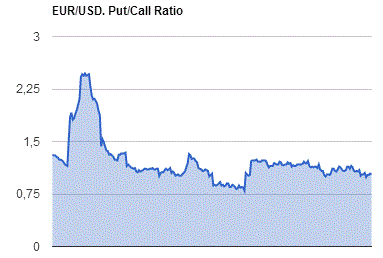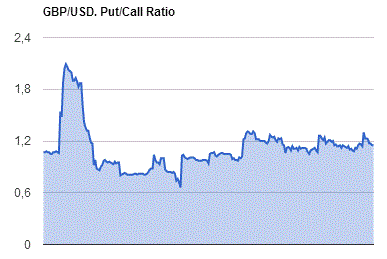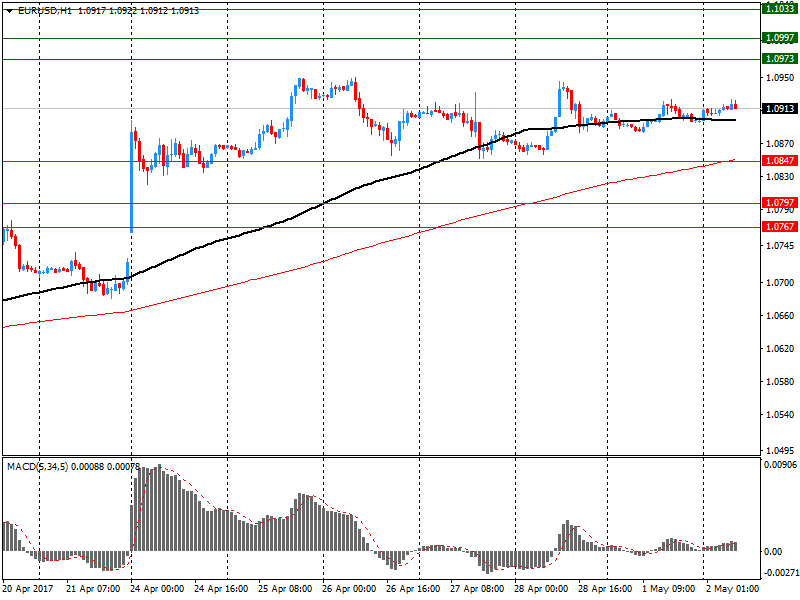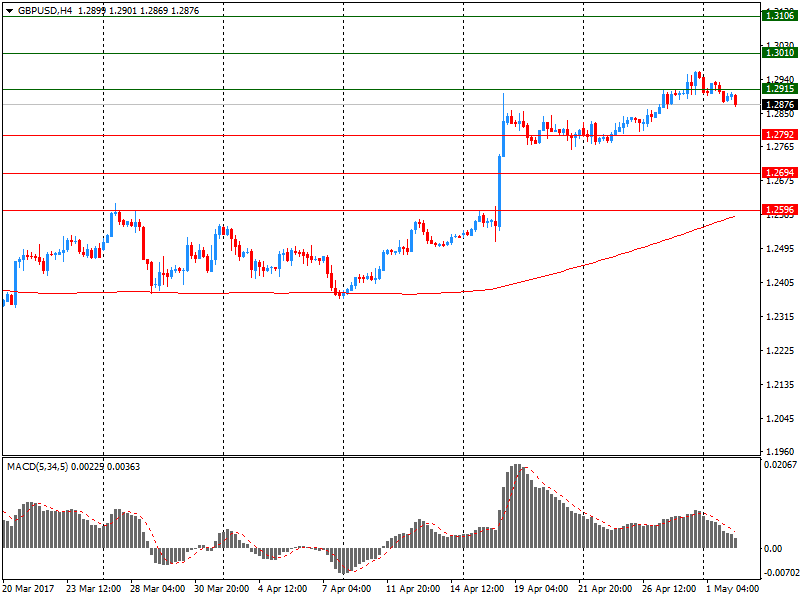Market news
-
23:30
Australia: AIG Services Index, April 53
-
22:45
New Zealand: Employment Change, q/q, Quarter I 1.2% (forecast 0.8%)
-
22:45
New Zealand: Unemployment Rate, Quarter I 4.9% (forecast 5.2%)
-
22:27
Currencies. Daily history for May 02’2017:
(pare/closed(GMT +2)/change, %)
EUR/USD $1,0928 +0,28%
GBP/USD $1,2934 +0,39%
USD/CHF Chf0,9915 -0,46%
USD/JPY Y112,01 +0,16%
EUR/JPY Y122,43 +0,44%
GBP/JPY Y144,88 +0,55%
AUD/USD $0,7533 +0,15%
NZD/USD $0,6933 +0,40%
USD/CAD C$1,3709 +0,21%
-
21:59
Schedule for today, Wednesday, May 03’2017 (GMT0)
07:55 Germany Unemployment Rate s.a. April 5.8% 5.8%
07:55 Germany Unemployment Change April -30 -12
08:30 United Kingdom PMI Construction April 52.2 52
09:00 Eurozone Producer Price Index, MoM March 0.0% -0.1%
09:00 Eurozone Producer Price Index (YoY) March 4.5% 4.1%
09:00 Eurozone GDP (YoY) (Preliminary) Quarter I 1.7% 1.7%
09:00 Eurozone GDP (QoQ) (Preliminary) Quarter I 0.4% 0.5%
12:15 U.S. ADP Employment Report April 263 180
13:45 U.S. Services PMI (Finally) April 52.8 52.5
14:00 U.S. ISM Non-Manufacturing April 55.2 55.8
14:30 U.S. Crude Oil Inventories April -3.641
18:00 U.S. Fed Interest Rate Decision 1% 1%
18:00 U.S. FOMC Statement
-
13:42
Russia's Putin says allegations of interference in US election are rumours
-
We have never interfered in other countries' political processes
-
We don't want others to interfere in our politics
-
Discussed anti-Kremlin protests with Merkel
-
Our law enforcement acted within law when breaking up protests
-
Agreed on need for full investigation of attack on Syria's Sheikh Hanoun
-
Death of OSCE observer does significant damage to peace effort
-
Those guilty should be found and punished
-
We decisively condemn any use of chemical
-
-
13:30
Option expiries for today's 10:00 ET NY cut
EURUSD: 1.0840-50 (EUR 470m) 1.0880 (387m) 1.0900-10 (711m) 1.0945-50 ( 813m) 1.1000 (1.6bln)
USDJPY: 111.25 (USD 912m) 111.50-60 (500m) 111.80 ( 1.9bln) 112.30 (285m)
AUDUSD: 0.7400 (AUD 200m) 0.7500 (321m) 0.7530 (243m) 0.7650 (185m)
NZDUSD 0.6975-85 (NZD (328m) 0.7100 (197m)
-
12:43
IMF spokesman says Greek deal for bailout reforms with lenders settles one issue for imf participation, debt relief still needed for Greece
-
12:03
Orders
EUR/USD
Offers: 1.0925 1.0935 1.0950-55 1.0980 1.1000 1.1030 1.1050
Bids: 1.0900 1.0885 1.0865 1.0850 1.08201 .0800 1.0780 1.0750 1.0700
GBP/USD
Offers: 1.2900 1.2925-30 1.2950-60 1.2975 1.3000 1.3020 1.3050
Bids: 1.2860 1.2830 1.2800 1.2775-80 1.2760 1.2750
EUR/JPY
Offers: 122.80 123.00 123.30 123.50 123.75 124.00
Bids: 122.30 122.00 121.85 121.65 121.50 121.00 120.75-80 120.50
EUR/GBP
Offers: 0.8485 0.8500 0.8530 0.8550
Bids: 0.8450 0.8430 0.8400 0.8385 0.8350
USD/JPY
Offers: 112.20 112.35 112.50 112.80 113.00
Bids: 112.00 111.80 111.50 111.20 111.00
AUD/USD
Offers: 0.7550 0.7565 0.7585 0.7600 0.7630 0.7650
Bids: 0.7520 0.7500 0.7480 0.7450 0.7430 0.7400
-
10:26
Bitcoin hits all-time high of $1,437 on Bitstamp exchange , up 3 percent on day
-
10:25
UK PM May's spokesman says media reports regarding London clearing houses post-Brexit are speculation
-
Says will not appeal court ruling that government must not delay publication of air pollution plan
-
-
10:00
Sterling hits day's high of $1.2915 after UK manufacturing growth hits 3-year high, up from $1.2886 beforehand
-
09:12
EU's Hahn says Turkey moving away from European perspective, its future relations with EU could be economic
-
09:10
Euro area unemployment rate up 0.1% to 9.6% in March
The euro area (EA19) seasonally-adjusted unemployment rate was 9.5% in March 2017, stable compared to February 2017 and down from 10.2% in March 2016. This is the lowest rate recorded in the euro area since April 2009. The EU28 unemployment rate was 8.0% in March 2017, down from 8.1% in February 2017 and from 8.7% in March 2016. This remains the lowest rate recorded in the EU28 since January 2009. These figures are published by Eurostat, the statistical office of the European Union.
Eurostat estimates that 19.716 million men and women in the EU28, of whom 15.515 million in the euro area, were unemployed in March 2017. Compared with February 2017, the number of persons unemployed decreased by 56 000 in the EU28 and by 5 000 in the euro area. Compared with March 2016, unemployment fell by 1.647 million in the EU28 and by 991 000 in the euro area.
-
09:01
Eurozone: Unemployment Rate , March 9.5% (forecast 9.4%)
-
08:39
Multi years high for UK manufacturing PMI
The start of the second quarter saw a solid improvement in the performance of the UK manufacturing sector. Rates of expansion in output, total new orders and new export work all gathered pace, underpinned by robust business confidence and driving further job creation.
The seasonally adjusted Markit/CIPS Purchasing Managers' Index rose to a three-year high of 57.3 in April, up from March's four-month low of 54.2. Survey data were collected 11-25 April. The PMI has signalled expansion for nine months in a row. The last time the PMI registered below its no-change mark was July 2016, the month following the EU referendum result.
-
08:30
United Kingdom: Purchasing Manager Index Manufacturing , April 57.3 (forecast 54)
-
08:19
The German manufacturing sector entered the second quarter of 2017 in a high gear - Markit
The German manufacturing sector entered the second quarter of 2017 in a high gear, according the latest PMI survey data from IHS Markit and BME. Overall operating conditions improved at a pace that almost matched the near six-year record set in March as output, new orders and employment all continued to grow at historically sharp rates. Cost pressures continued to intensify, however, with the rate of input price inflation accelerating for a survey-record ninth consecutive month to the highest since May 2011.
The PMI registered 58.2 in April, little-changed from March's 58.3 and indicative of a further sharp improvement in manufacturing business conditions in Germany. The downward tick in the PMI reflected slightly weaker growth rates for output, new orders and employment as well as a contraction in stocks of purchases, although these trends were almost wholly offset by the greatest lengthening in suppliers' delivery times in six years. The current 29-month period of overall growth in the goodsproducing sector is the second-longest in the 21- year survey history
-
08:17
The eurozone manufacturing sector continued to gain momentum
The eurozone manufacturing sector continued to gain momentum at the start of the second quarter. At 56.7 in April, up from 56.2 in March, the final Markit Eurozone Manufacturing PMI rose to a six-year high.
The PMI was only a tick below the earlier flash estimate of 56.8. Seven out of the eight nations covered recorded an improvement in operating conditions. The sole exception was Greece, where a deterioration was signalled for the eighth straight month. Growth was led by Germany, which saw its rate of expansion remain close to March's 71-month high.
The Netherlands PMI held steady at its March level. This performance was sufficient to place the Netherlands third in the PMI growth rankings, only slightly behind Austria in second position.
-
08:00
Eurozone: Manufacturing PMI, April 56.7 (forecast 56.8)
-
07:55
Germany: Manufacturing PMI, April 58.2 (forecast 58.2)
-
07:51
France: Manufacturing PMI, April 55.1 (forecast 55.1)
-
07:31
Switzerland: Manufacturing PMI, April 57.4 (forecast 58.3)
-
06:43
BoJ Gov Kuroda: it's simply not possible for ADB, World Bank to fill infrastructure needs completely, regional development banks would be welcome to participate in infrastructure building in region
-
Realistic way is to promote regional initiatives and linking with each other those initiatives, rather than having single asian initiative
-
Geopolitical conflict is not good for anyone, must be avoided by political will
-
Establishment of aiib, joining of many asian countries to the aiib, is good because infrastructure needs in asia are huge
-
-
06:38
Options levels on tuesday, May 2, 2017
EUR/USD
Resistance levels (open interest**, contracts)
$1.1033 (3175)
$1.0997 (4209)
$1.0973 (4186)
Price at time of writing this review: $1.0913
Support levels (open interest**, contracts):
$1.0847 (1147)
$1.0797 (1394)
$1.0767 (1310)
Comments:
- Overall open interest on the CALL options with the expiration date June, 9 is 72964 contracts, with the maximum number of contracts with strike price $1,1100 (7123);
- Overall open interest on the PUT options with the expiration date June, 9 is 75482 contracts, with the maximum number of contracts with strike price $1,0200 (5274);
- The ratio of PUT/CALL was 1.03 versus 1.03 from the previous trading day according to data from May, 1

GBP/USD
Resistance levels (open interest**, contracts)
$1.3106 (2139)
$1.3010 (2542)
$1.2915 (1277)
Price at time of writing this review: $1.2876
Support levels (open interest**, contracts):
$1.2792 (1244)
$1.2694 (879)
$1.2596 (1462)
Comments:
- Overall open interest on the CALL options with the expiration date June, 9 is 25212 contracts, with the maximum number of contracts with strike price $1,3000 (2542);
- Overall open interest on the PUT options with the expiration date June, 9 is 29120 contracts, with the maximum number of contracts with strike price $1,2500 (5034);
- The ratio of PUT/CALL was 1.16 versus 1.15 from the previous trading day according to data from May, 1

* - The Chicago Mercantile Exchange bulletin (CME) is used for the calculation.
** - Open interest takes into account the total number of option contracts that are open at the moment.
-
06:19
Latest data indicated that Chinese manufacturers started the second quarter with a further slowdown in production - Markit
Latest data indicated that Chinese manufacturers started the second quarter with a further slowdown in production and new business growth. Employment across the sector meanwhile declined at the fastest pace since the start of the year and input buying rose only slightly. At the same time, optimism towards the 12-month outlook was the weakest seen in 2017 so far. Cost pressures continued to ease from the peaks seen at the end of last year, and contributed to only a modest rise in prices charged.
The seasonally adjusted Purchasing Managers' Index - a composite indicator designed to provide a single-figure snapshot of operating conditions in the manufacturing economy - registered 50.3 in April, down from 51.2 in March to signal only a marginal improvement in overall operating conditions. Moreover, the latest upturn in the health of the sector was the weakest seen since last September.
Slower increases in output and new orders were key factors weighing on the headline index reading in April. Production growth softened for the second month running and rose only marginally overall. Total new business followed a similar trend, and rose at weakest pace since last September.
-
06:18
Trump to speak with Russia's Putin in call Tuesday - Bloomberg
-
06:15
RBA decided to leave the cash rate unchanged at 1.50%
"At its meeting today, the Board decided to leave the cash rate unchanged at 1.50 per cent.
There has been a broad-based pick-up in the global economy since last year. Labour markets have tightened further in many countries and forecasts for global growth have been revised up. Above-trend growth is expected in a number of advanced economies, although uncertainties remain. In China, growth is being supported by increased spending on infrastructure and property construction, with the high level of debt continuing to present a medium-term risk. The improvement in the global economy has contributed to higher commodity prices, which are providing a significant boost to Australia's national income. Australia's terms of trade have increased, although some reversal of this is occurring.
Headline inflation rates have moved higher in most countries, partly reflecting the higher commodity prices. Core inflation remains low. Long-term bond yields are higher than last year, although in a historical context they remain low. Interest rates have increased in the United States and there is no longer an expectation of additional monetary easing in other major economies. Financial markets have been functioning effectively.
The Bank's forecasts for the Australian economy are little changed. Growth is expected to increase gradually over the next couple of years to a little above 3 per cent. The economy is continuing its transition following the end of the mining investment boom, with the drag from the decline in mining investment coming to an end and exports of resources picking up. Growth in consumption is expected to remain moderate and broadly in line with incomes. Non-mining investment remains low as a share of GDP and a stronger pick-up would be welcome".
-
06:14
Greece, EU/IMF Lenders Reach On Bailout Reforms - Greek FinMin Official @LiveSquawk
-
04:30
Australia: Announcement of the RBA decision on the discount rate, 1.5% (forecast 1.5%)
-
01:45
China: Markit/Caixin Manufacturing PMI, April 50.3 (forecast 51.2)
-

